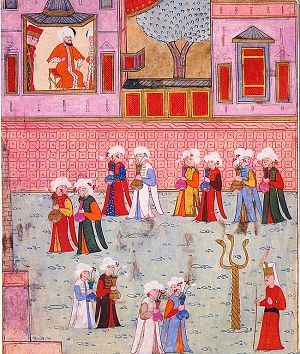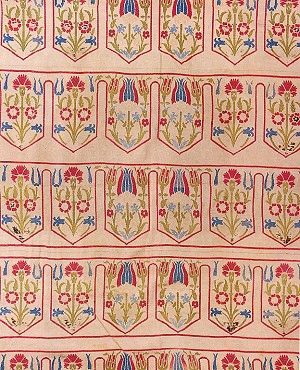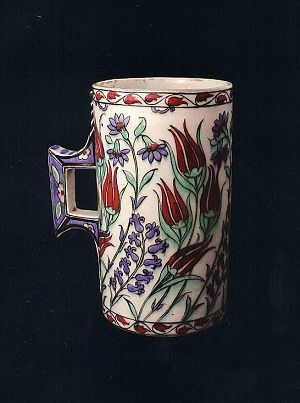Ottoman
Early 17th century kaftan worn by Sultan Ahmed I (1603-1617) as a child. The composition consist of pine cones in the form of stylised cypress trees woven in gold, surrounded by tulips and carnations and set in floral medallions with tulip finials. Child’s kaftan. TOPKAPI PALACE MUSEUM
Naturalistic flowers such as hyacinths, carnations and tulips began to appear in Iznik ceramics during the reign of Suleyman the Magnificent. This 16th century plate with a design of cloud bands and spirals around the rim id decorated with a large tupip curving anticlockwise. Iznik plate. PRIVATE COLLECTION
One of the compositions of flowers illustrating the collected poems of Gazneli Mahmud in a manuscript dated 1685. This symmetric composition consists of tulips, carnations and narcissi in a vase of opaque white glass. Gaznevi Album. ISTANBUL UNIVERSITY LIBRARY
Flowers played an important role in palace celebrations. This miniature painting depicts member of the guild of spice sellers carrying vases of flowers at the festivities for the circumcision of Prince Mehmed, son of Sultan Murad III in the late 16th century. Surname-I Humayun. TOPKAPI PALACE MUSEUM
The Ottoman love of flowers in reflected in the arts of the book, including bindings. Early lacquered bindings were decorated with stylised flowers, while in later examples the flowers are more naturalistically drawn. Lacquered binding. TOPKAPI PALACE MUSEUM
Jewelled gold aigrette in the form of a carnation belonging to one of the Ottoman sultans. Aigrettes were attached to turbans as ornaments, and also presented as gifts by the sultans to foreign rulers and statesmen. Jewelled aigrette. MUSEUM OF TURKISH AND ISLAMIC ART-ISTANBUL
Ceremonial shield dating from the late 16th century. The shield is made of wicker wound with raw silk in a design of tulips and carnations. the central iron boss bears a star motif. Wicker shield. TOPKAPI PALACE MUSEUM.
Tobacco pouch made of figured silk bocade with a design of carnations in gold and blue on a red ground dating from the 16th century. Girls engaged to be married sewed and embroidered such pouches as gifts for their husbands-to-be. Pouches of different sizes were used for carrying money, seals, watches and tobacco. Tobacco pouch. TOPKAPI PALACE MUSEUM.
Kaftan of red satin belonging to Sultan Murad III (1574-1595). The bold design of large silver tulips and crescents worked in applique enhanced the splendid appearance of the wearer. Satin kaftan. TOPKAPI PALACE MUSEUM.
A flower garden in cut-paper work on a mid-16th century lacquered binding. The composition includes fruit trees in blossom, roses, tulips, irises and hyacinths. Lacquered binding. TOPKAPI PALACE MUSEUM
Cut-paper work composition of flowers in tall vases. The flowers include narcissi, tapering Ottoman tupips, chrysanthemums and roses. Cut-paper composition. DEPARTMENT OF WAKFS
Some of the illustrations in the Gaznevi Album are in a mixed technique of painting, collage and cut-paper work, their materials including coloured paper and sequins. This example is a composition of flowers beneath a scrollwork floral bower. The fritillaria in the centre is a rare example of this flower in the art of decoration. Gaznevi Album. ISTANBUL UNIVERSITY LIBRARY.
Detail of panel from a late 19th century Ottoman royal tent. In the centre diverse flowers and foliage spring from cabbage leaves. the composition with bunches of grapes pendant from the sides of the arch displays Western influence. Tent wall fragment. MILITARY MUSEUM – ISTANBUL
Iznik plate circa 1575 with a design of carnations in a naturalistic style, serrated leaves, and flowers resembling anemones springing from a leafy clump. The border is decorated with cloud bands and scroll motifs. Iznik plate. PRIVATE COLLECTION.
Illustration of diverse flowers in a vase set upon a low stool flanked by cherries and a pear. The flowers include an anemone, rose, cornflowers, hyacinths and tulips. Ganevi Album. ISTANBUL UNIVERSITY LIBRARY.
Mattress cover woven in a design of tulips, rosebuds and huacinths dating from the late 16thcentyry. Mattress cover. TOPKAPI PALACE MUSEUM.
Iznik tankard with a sesign of tulips, hyacinths and narcissi that seem to be blowing in the breeze. The tulip was one of the best belowed flowers in the Ottoman period and symbolised perfection and eternal love. Ceramic tankard. PRIVATE COLLECTION
Binding of a manuscript dated 1757. The central medallion, pendants and corner pieces are decorated with naturalistic floral compositions. Kuran ve Risaleder. TOPKAPI PALACE MUSEUM.
Cut-paper work illustration of a pavilion flanked by cypress trees in a garden filled with tulips and other flowers. The illustration is from an album dated 1687 by the calligrapher Mehemed bin Ahmed Sirozi. Calligraphy album. KONYA MEVLANA MUSEUM.
One of the illustrations from a collection of poems by Gazneli Mahmud. The composition consits of tulips, carnations and roses growing in a garden. An unusual feature is the stamped inscription in the centre of each flowers. Gaznevi Album. ISTANBUL UNIVERSITY LIBRARY.
Interior panels of an imperial tent belonging to Sultan and blossoming fruit trees are worked on a ground of light green taffeta and satin. Above each tree is a star and crescent motif. Single-pole square tent. MILITARY MUSEUM - ISTANBUL

/https%3A%2F%2Fprofilepics.canalblog.com%2Fprofilepics%2F1%2F0%2F100183.jpg)
/https%3A%2F%2Fstorage.canalblog.com%2F03%2F02%2F119589%2F96711876_o.jpg)
/https%3A%2F%2Fstorage.canalblog.com%2F11%2F31%2F119589%2F94773502_o.jpg)
/https%3A%2F%2Fstorage.canalblog.com%2F20%2F83%2F119589%2F94772815_o.jpg)
/https%3A%2F%2Fstorage.canalblog.com%2F26%2F72%2F119589%2F75604929_o.jpg)
/https%3A%2F%2Fstorage.canalblog.com%2F59%2F60%2F119589%2F26458628_o.jpg)























/http%3A%2F%2Fstorage.canalblog.com%2F44%2F97%2F119589%2F128680994_o.png)
/http%3A%2F%2Fstorage.canalblog.com%2F22%2F37%2F119589%2F128680891_o.png)
/http%3A%2F%2Fstorage.canalblog.com%2F72%2F79%2F119589%2F126939276_o.jpg)
/http%3A%2F%2Fstorage.canalblog.com%2F39%2F73%2F119589%2F126267130_o.jpg)